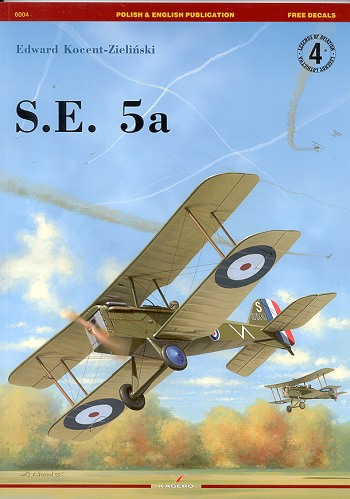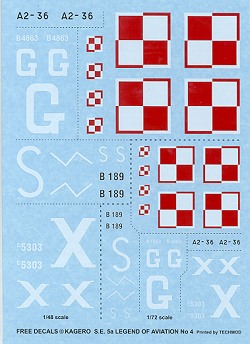 Continuing with the 'Legends of Aviation' series, it is in
the now standard 9x12 softbound format and consists of 72 pages
on high quality, glossy paper. As with all Kagero books it is a combination
of Polish and English. While there are some rather odd uses of syntax, it
is not something that makes the book unreadable.
Continuing with the 'Legends of Aviation' series, it is in
the now standard 9x12 softbound format and consists of 72 pages
on high quality, glossy paper. As with all Kagero books it is a combination
of Polish and English. While there are some rather odd uses of syntax, it
is not something that makes the book unreadable.
The book begins with the usual operational story to set the
scene then goes into a brief history of the forming of the Royal Flying
Corps (called the British Air Force in the book). Then there is the
development of the SE.5, which in many respects is the search for a decent
liquid cooled aero engine. The SE.5 used a rather large variety of V-8
power plants and much of the book covers these variants. The airframe was
also built by quite a few different manufacturers; each adding their own
small trademarks to the aircraft.
When one gets into the operational use of the SE.5, the
author has chosen to do a brief synopsis of the aircraft's use by squadron.
This section is divided into operational theaters with the Western Front
receiving the lion's share of attention. It is followed by foreign use of
the SE.5, in some cases being as few as one or two airframes. The final
written sections cover museum and replica aircraft, as well as camouflage
and markings.
 Kagero is known for its diagrams section and this one is no
exception with many pages of drawings to 1/48 scale that note all the
differences in the airframe over its life time. Following this section are
two pages of profiles covering 8 aircraft. Profiles are also in the inside
of the front cover and the outside of the back cover. Every Kagero book now
comes with decals by Techmod. This book has markings for three RFC, one
Australian, and one Polish aircraft. These are covered by the profiles and
with the exception of the Polish aircraft (which is just insignia), offer
only unique markings. Insignia need to come from the kits used or other
sources. The markings are in both 1/72 and 1/48 scale.
Kagero is known for its diagrams section and this one is no
exception with many pages of drawings to 1/48 scale that note all the
differences in the airframe over its life time. Following this section are
two pages of profiles covering 8 aircraft. Profiles are also in the inside
of the front cover and the outside of the back cover. Every Kagero book now
comes with decals by Techmod. This book has markings for three RFC, one
Australian, and one Polish aircraft. These are covered by the profiles and
with the exception of the Polish aircraft (which is just insignia), offer
only unique markings. Insignia need to come from the kits used or other
sources. The markings are in both 1/72 and 1/48 scale.
Overall, a really fine, if somewhat disjointed reference on
the type and one that I can recommend.
You can find this book and many others at

If you would like your product reviewed fairly and quickly by a
site that has around 300,000 visitors a month, please contact
me or see other details in the Note to
Contributors.
 Continuing with the 'Legends of Aviation' series, it is in
the now standard 9x12 softbound format and consists of 72 pages
on high quality, glossy paper. As with all Kagero books it is a combination
of Polish and English. While there are some rather odd uses of syntax, it
is not something that makes the book unreadable.
Continuing with the 'Legends of Aviation' series, it is in
the now standard 9x12 softbound format and consists of 72 pages
on high quality, glossy paper. As with all Kagero books it is a combination
of Polish and English. While there are some rather odd uses of syntax, it
is not something that makes the book unreadable. Kagero is known for its diagrams section and this one is no
exception with many pages of drawings to 1/48 scale that note all the
differences in the airframe over its life time. Following this section are
two pages of profiles covering 8 aircraft. Profiles are also in the inside
of the front cover and the outside of the back cover. Every Kagero book now
comes with decals by Techmod. This book has markings for three RFC, one
Australian, and one Polish aircraft. These are covered by the profiles and
with the exception of the Polish aircraft (which is just insignia), offer
only unique markings. Insignia need to come from the kits used or other
sources. The markings are in both 1/72 and 1/48 scale.
Kagero is known for its diagrams section and this one is no
exception with many pages of drawings to 1/48 scale that note all the
differences in the airframe over its life time. Following this section are
two pages of profiles covering 8 aircraft. Profiles are also in the inside
of the front cover and the outside of the back cover. Every Kagero book now
comes with decals by Techmod. This book has markings for three RFC, one
Australian, and one Polish aircraft. These are covered by the profiles and
with the exception of the Polish aircraft (which is just insignia), offer
only unique markings. Insignia need to come from the kits used or other
sources. The markings are in both 1/72 and 1/48 scale. 